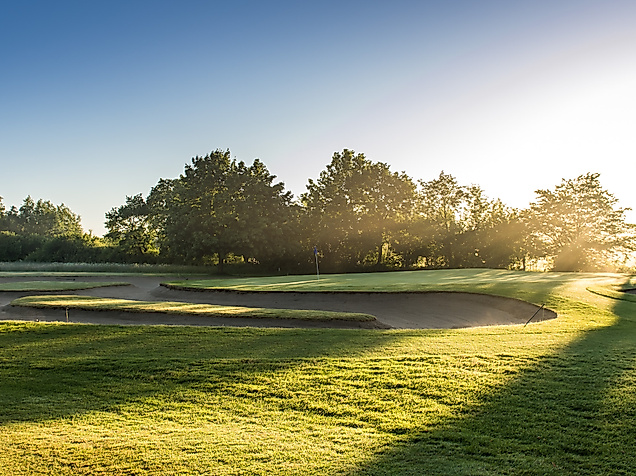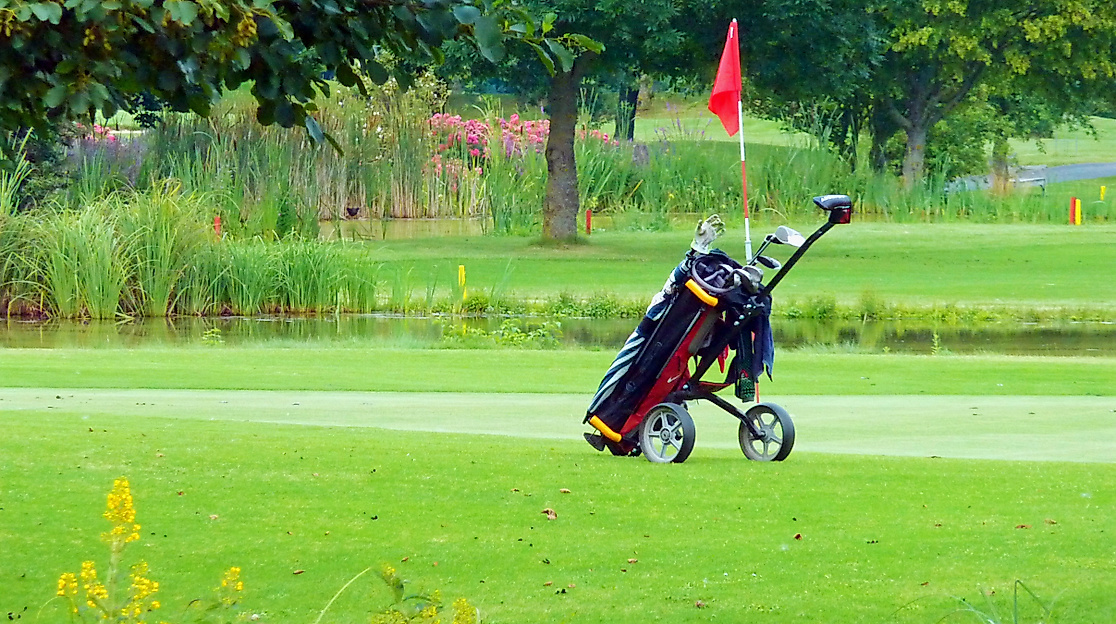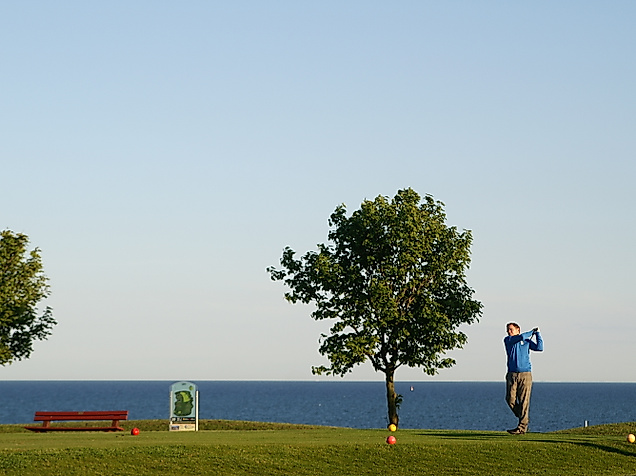
Golf lexicon
If golf is new territory for you or if you are unfamiliar with some of the technical terms, you will certainly find an explanation in the golf lexicon.
Ace:
The ball is played into the hole with just one shot (hole in one) - this is usually only possible on par 3 or extremely short par 4 holes.
Albatross:
If a hole was played in three under par, it's called an albatross. Example: a hole marked as par 5 is made in two strokes.
Amateur:
A player who doesn't make money playing golf.
Bag:
Golf bag in which all clubs and accessories such as balls and tees are stored and transported during the round of golf. No more than 14 clubs are allowed in any one tournament.
Ball marker:
Object for marking the exact position of the recorded ball.
Birdie:
If you play a hole "one under par", you get a birdie. A par 4 hole, for example, is a hole that the player has completed in just three strokes.
Bogey:
If a hole is finished with a shot over par, this is a bogey. Two strokes over par are called double bogey, three strokes triple bogey.
Break:
Unevenness in the green deliberately built in by the golf architect: The green is then not flat, but has small elevations and depressions. Result: Instead of rolling straight ahead regularly, the ball is deflected, braked or accelerated by the breaks.
Bunker:
A hollowed-out obstacle on the fairway or around the green to make the game more difficult. Mostly filled with sand.
Caddy:
Good helper who carries the bag for the player, advises him on the choice of clubs and notes the number of strokes required (score). The trolley for the golf bag is also called caddy or trolley.
Chip:
Approaching the flag. In contrast to the pitch, the ball rolls most of the distance covered. One of the most important golf strokes ever.
Cut:
Qualification for the final round of a tournament. In major tournaments, for example, after two out of four rounds, the tournament ends for all players above the cut, i.e. a certain number of strokes; they have "failed the cut".
Divot:
Insert and tread firmly on the turf that has been knocked out during the shot on the fairway - not on the tee.
Driver:
The golf club with the longest shaft and the lowest tilt angle on the club head used for the tee. Also called wood 1.
Driving range:
Practice area that is used, for example, for training golf swings.
Eagle:
Finish a hole with two strokes under par. An eagle on a par-3 is an ace or hole in one.
Etiquette:
Rules of conduct on the golf course - safety and consideration, privileges and protection of the course. Failure to do so will not result in penalty shots.
Fairway:
Shortly mown fairway between tee and green. Limited by the higher cut rough.
Flight:
Game group - the number of players forms the flight. One round of golf may be played by a maximum of four players.
Green:
Green target area - the briefly mown area around the hole.
Green fee:
Course fee for golfers from other clubs. The height varies from place to place. Often there is a difference between weekends and working days.
Greenkeepers:
Trained course attendants who take care of the golf course.
Handicap:
The playing strength of a golfer. This is the number of strokes a player needs more than the number of strokes specified on a court. For example, a handicap of 20 means that a player on a course with a target of 72 strokes needs a total of 92 strokes - i.e. 20 additional strokes. The handicap is a minus number for almost all players, which is why the negative sign is often omitted. Therefore, the lower the handicap, the better the player.
To qualify for “Platzreife”, you need a handicap of at least 54 in Germany. Many golf courses require a minimum handicap of about 36 or better. The term handicap is also used to describe the game.
Heathland Course:
Usually refers to a golf course built in a heath-like landscape. Usually has a small tree population.
Hole:
The hole in which the ball must land at the end of each hole is 10.2 centimetres deep and 10.8 centimetres in diameter. There's a flag in the middle of the hole. A hole is also the name given to each individual hole.
Hole in One:
See "ace."
Iron:
Golf clubs for short, precise strokes. The iron with the longest shaft and the smallest angle of inclination of the club face (loft) is iron 1. Irons 1 to 4 are used for long distances, irons 5 to 7 for medium distances, irons 6 to 9 and the pitching wedge for short distances.
Links Course:
A golf course in a dune landscape directly at the sea.
Lob:
High, very short shot on the green.
Loft:
Angle of inclination of the club face. The larger the angle, the higher the trajectory and the smaller the width of the stroke.
Long hitter:
Denotes a golfer who can hit the ball particularly far.
19th hole:
Funny name for the clubhouse, where you meet for a cosy get-together after a round of golf.
Obstacle:
The special thrill of the game is provided by sand holes (bunkers), water holes and other ingenious obstacles designed by the architect.
Par:
Default number of strokes on a path, depending on its length. This is how many shots a "pro" needs for a single hole or a round of golf. Par stands for "Professional Average Result".
Parkland Course:
Usually refers to a golf course located in a "park-like" area, i.e. has a lot of trees.
PGA:
Abbreviation for "Professional Golfers Association". With country code, for example: PGA of Germany.
Pitch:
The short and mostly high blow in the direction of the flag marking the hole. Usually done with a wedge club. Unlike the chip, here the ball flies more than it rolls.
Pitch mark:
The depression left by the (high) ball hitting the green.
Pitch fork:
Instrument for mandatory removal of the pitch mark on the green.
Pitching wedge:
A racket (iron) with a very strong loft, which causes the ball to rise and fall steeply and roll little. Particularly used when approaching the green.
“Platzreife” (Course permit):
To play on a golf course, you need at least a course permit; on some courses, a certain handicap is also required. For the “Platzreife” (also called “Platzerlaubnis”) - course permit - one must prove both theoretical and practical knowledge and pass an examination. In many other countries, such as the USA, there is no Platzreife.
Pro Professional:
Professional Playing Pro or Golf Instructor (Teaching Pro).
Proshop:
Shop for golf equipment, mostly directly at the clubhouse.
Putt:
With this stroke, the ball should exceptionally not fly, but roll, ideally directly into the hole.
Putter:
Special club to pocket the ball.
Putting Green:
Course with several holes on which to practice putting.
Rabbit:
A rookie who hasn't got a handicap yet.
Rough:
Terrain around the fairway - often high and dense grass that makes the shots difficult.
Score:
A hit result on a hole or on the round. After each hole it is entered on the scorecard.
Shotgun start:
In a tournament, all participants tee off at the same starting time. For this purpose, they are distributed over all the holes of a course. The start is often made by an acoustic signal, such as a pistol shot.
Slope:
Level of difficulty of the course, which is taken into account when determining the handicap.
Stableford (Stfd):
Counting method according to the Englishman Dr. Frank Stableford (for the first time 5/16/1932), in which not the number of strokes, but the number of points is decisive. This leads to the gross (actual strokes) and net valuation taking into account the handicap (Stfd). Most competitions in the Deutschland Golfreisen are played according to the Stableford system.
Strategy:
"Reading the green" and when "putting" aim next to the hole so that the ball rolls into the hole in a curve.
Tee:
The first shot of any fairway. A plain, mostly rectangular and often slightly elevated grass area.
German golf courses usually have four different tees per course: Women's tee shot (red) and men's tee shot (yellow) as well as one tournament tee shot each for women (black) and men (white).
Tee:
Small pin made of wood or plastic on which the golf ball is placed (only when teeing off!) in order to be able to hit it better. Golfers also call the place where they tee off "tee".
Tee Time:
The reserved time at which players can start a round of golf on the first tee of the course.
Trolley:
Small car for the bag. After all, several kilometres are covered during a round of golf. If you like more comfort, you can rent an electric trolley or even a golf buggy (a small electric car specially built for the golf course) to steer the golf bag over the course.
Wedges:
Special iron for short, high blows, or for blows from the sand.
Wood:
Light golf club with a large oval head and a long shaft for long shots.


